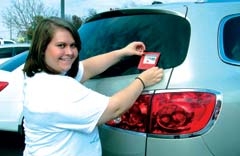Don’t Wreck the Holidays
December is National Impaired Driving Prevention Month.
By: Carol Beck-Round | Category: In Our Communities | Issue: December 2013

Megan Lopez, Claremore High School student, places a decal on a car window to encourage others to pledge never to ride with an impaired driver. Lopez, who has been a member of Students Against Drunk Driving (SADD) for three years, currently serves as secretary of the organization.
As we all know, it is against the law to get behind the wheel of a motor vehicle after having one drink too many at happy hour or using illegal drugs. If caught driving drunk or high, penalties in Rogers County can include jail time, court fees and fines, and driving restrictions. Many are not aware, however, that driving after taking prescription medicine can also lead to impaired driving and the related criminal charges. People often assume that only illegal drug use could result in a DUI (driving under the influence) charge. “What Healthy Community Partnership members want to let everyone know is that taking any sort of substance (alcohol, medication or illicit drugs) impairs your ability to operate your vehicle is breaking the law," said Trisha DeLozier, HCP certified prevention specialist. December is National Impaired Driving Prevention Month and focuses on both drunk driving and the growing problem of drugged driving. Drugged driving has been overlooked for a number of years, but research shows it may be responsible for more than 20 percent of car crashes.
The Oklahoma Highway Safety Office reports that in 2012 there were 19 drivers under the age of 21 with a drug-related driver condition and passengers in their vehicle. Fortunately, there were no passenger fatalities, but 12 were seriously injured. In the same year, there were 106 drivers age 21 and older with a drug-related driver condition and passengers in the vehicle. One passenger was killed and 81 others were seriously injured.
To demonstrate further the increased problem of drugged driving, a national survey shows drugs were present more than seven times as frequently as alcohol among weekend nighttime drivers in the United States.
“One problem,” says DeLozier, “is that law enforcement officers currently have no technology to help them identify drugged drivers. With alcohol a Breathalyzer is useful, but new funding is being sought on the federal level to research methods such as a saliva test for the drugged driving suspects.” In addition, to combat the problem, drug recognition trainings are becoming more common and officers can become certified as a Drug Recognition Expert (DRE).
“‘Don’t Wreck the Holidays’ is a message we hope to promote this month,” said Amy Graham, a project director at Volunteers for Youth and an HCP member. “Impaired driving can affect every one of us, even if we are not the one driving under the influence,” she added.
Conservative estimates show drugged driving is responsible for 440,000 injuries and $59.9 billion in costs each year. Of the people who died in impaired crashes (other than drivers) 1,612 were passengers, 1,049 were occupants of other vehicles, 710 were pedestrians or bicyclists, and 91 were child passengers.
Impaired driving fatalities occur all year-round, but data shows that the holiday season is a particularly dangerous time on the roadways. Many of these tragedies could have been avoided. Most occurred because of a person’s bad decision to drive after drinking alcohol and often combining that with prescription medications or other drugs. “When you choose to drive while impaired, you are endangering yourself, your passengers, and those on the road around you,” Graham added.
Volunteers for Youth and Healthy Community Partnership are working to bring awareness about this preventable tragedy by providing window clings and stickers to Rogers County high school students for distribution to friends and parents. “We ask that you help to share this message this holiday season,” said Graham. “‘Don’t Wreck the Holidays: Pledge to never accept a ride with an impaired driver.’”
For more information, contact
Healthy Community Partnership and Volunteers for Youth
1700 S. Lynn Riggs Blvd.Claremore, OK 74017(918) 260-0301
eat0@eau0eav0eaw0

About Author Carol Beck-Round
After 30 years in public school education, Carol Round retired and moved from Grand Lake to Claremore, Oklahoma in 2005, where she writes a weekly faith-based column which runs in 14 Oklahoma newspapers as well as several national and international publications. Three volumes of her columns have been compiled into collections: A Matter of Faith, Faith Matters and by FAITH alone. She has also written Journaling with Jesus: How to Draw Closer to God and a companion workbook, The 40-Day Challenge. This past year she has written three children’s books, a series called Nana’s 3 Jars, to teach children about the value of giving, saving and spending money. All of Carol’s books are available through Amazon. In addition to writing her weekly column, authoring books and speaking to women’s groups, she writes for Value News. She also blogs regularly at www.carolaround.com. When she is not writing or speaking, she loves spending time with her three grandchildren, working in her flowerbeds, shooting photos, volunteering at her church or going on mission trips overseas, and hiking. She is also an avid reader and loves working crosswords and trying to solve Sudoku puzzles.
Volunteers for Youth
For more information, contact:
Volunteers for Youth
(918) 343-2530
1810 N. Sioux Ave. Ste. A | Claremore, OK
volunteersforyouth.com
![]()
More about Volunteers for Youth:
More ArticlesCurrent Coupons/OffersSubscribe
For Free!



